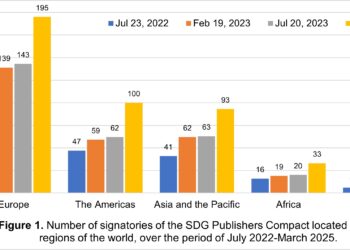 The practice of publishing a journal article online and then post-dating its official release several months later as it is slotted into a print issue is not uncommon. This practice, however, can be manipulated into increasing a journal’s impact factor, argues Frank Krell in a new article published — online, one month in advance — in the April issue of Learned Publishing.
The practice of publishing a journal article online and then post-dating its official release several months later as it is slotted into a print issue is not uncommon. This practice, however, can be manipulated into increasing a journal’s impact factor, argues Frank Krell in a new article published — online, one month in advance — in the April issue of Learned Publishing.
In his article, “Academic publishers’ time-loop: another mechanism to manipulate impact factors?“ Krell argues that post-dating publication dates buys an article more time to be cited, and that the effect is greatest when articles, published online at the end of one year (e.g., December, 2011), are post-dated to appear in the first issue of the next year (e.g., January, 2012). In these cases, the contribution of article citations toward the journal’s impact factor are shifted ahead by one year (e.g., from 2012-2013 to 2013-2014). He writes:
Whether this effect is intended by publishers, or just tolerated, it is likely to increase Journal Impact Factors. At any rate, even if not all journals are affected considerably, the publication date should be the date of the actual publication, not a meaningless clerical tool that can be used at will to influence citation metrics.
While Krell’s position is sound, it is based on personal anecdote. According to Marie McVeigh, Director of the Journal Citation Report (JCR) and Bibliographic Policy for Thomson Reuters, “We have no data to suggest that manipulating publication dates is influencing JCR metrics.”
It’s very difficult to predict the citation pattern for an individual article, explained McVeigh. Shifting the window of observation one year forward or one year back can backfire. “It can be like robbing Peter to pay Paul.”
While many science journals use a first-in/first-out production schedule, editors can adjust the publication date of articles for various reasons, such as in the compilation of special issues or because there is reason to publish two or more related articles in a given issue. Editors will also time the release of articles to closely follow a conference presentation, or for various related reasons, none of them having to do with their impact factor.
To me, there needs to be some evidence — even anecdotal — that editors are purposefully post-dating publication for the purposes of citation gaming. Large January issues may be one piece of evidence; however, it may also signal the funding and publication cycle of academics. I’d be more interested to know whether post-dating conversations are going on within editorial boards, or whether authors have been told that the editor is holding back their article to maximize its contribution to the journal’s impact factor.
Editors may be playing their own version of “The Post-Dating Game,” but without more evidence, Krell’s claim should be considered a conjecture.
Discussion
11 Thoughts on "Does Post-Dating Publication Help Journal Impact Factors?"
I think this hypothesis is giving publishers way too much credit as evil geniuses. If I had the time and wherewithal to plot out in advance the citation trajectory of each paper and slot it into an ideal release time, then well, I’d have a lot more time and cleverness than I currently possess.
Publish-Ahead-of-Print is an artifact brought on by the nature of the page budgets necessitated by the print product. As print slowly fades away, so will PAP. Instead, you’ll just have P. Authors want their papers available as quickly as possible. That’s what’s happening here, not some nefarious plot to game the impact factor.
I think there is some merit to Krell’s conjecture, and could imagine that such behavior may be found in second-tier journals trying desperately to move themselves into the first tier, such as When Journal Editors Coerce Authors to Self-Cite. Finding the pattern would be the first step, yet we’d still need to find a smoking gun, like incriminating correspondence between the editor and publisher to move articles from the December to January issue for citation planning purposes.
So, Krell may not be wrong. There is just no supporting evidence to his claim.
I had a paper published ahead of print in 2011. It received no citations in 2011. Then, I noticed that the e-publication date was changed to January 5, 2012. Hard to explain this in a way other than IF manipulation.
The way I understand that things work (at least for the journals I’m involved with) is that after the article is accepted, it’s published online as an “Advance Access” or “Publish-Ahead-of-Print” article. It is given a DOI and the date it went up is noted on the article. Different journals have different backlogs of such articles. Some put the article directly into the next month’s issue. Some have so many lined up that the article doesn’t officially go into an issue for months, or even years. When the article goes into an issue, this version is dated with the date of the issue. It keeps the same DOI and should note somewhere on it that the articles was first published online with the initial date. This is not done to cheat the Impact Factor but is instead an artifact of the print publication process, where journals are limited to a certain number of pages per issue.
As I understand things, articles don’t count toward the Impact Factor until they’re officially published in an issue. So the current (at least until next week) IF counts 2010 citations to articles that were in issues in 2008 and 2009. I suppose one could do a detailed study on each individual paper and its subject matter and predict at what point in its lifespan it would draw the most citations and then set up placement in an issue to coincide with that period. But it’s not a standard practice at any journal that I know of, and would probably infuriate authors, who want their papers out in the first issue possible.
The “calendar” factor shall be difficult to implement, but I have absolutely no doubt publishers have pushed “online first” articles for many reasons, including the increase the IF of their journals, as litterature have shown that “publication lag” is a strong factor in the rise of IF (just ask social sciences journals about it as a counter-example).
So three different effects have to be documented and discussed :
1/ the “technical” effect of accessibility of the paper prior to the official release date, making it available to readers/writers.
2/ the “searched” effect of time delay, papers get earlier and earlier online (just subjective impression, has to be verified)
3/ the “calendar” effect, post-dating papers : it can be imagined if editors/publishers have sufficient data (the “searched” effect) to separate future blockbusters from normal papers as IF is in fact a result of the former.
Please consider whether post-dating may have an effect on the publication date required in an application to register copyright (whether by the author in the event of a licensed publication or by the publisher in the event that copyright is subject to an author’s assignment). The relationship between the claimed date of publication and effective date of registration may affect the damages calculation in an infringement situation. Note too, however, that the Copyright Office has not taken a position on whether an online publication constitutes distribution; it appears that it may not if the online publication is non-downloadable.
I think this does happen, and not just in second-tier journals. Colleagues from other (large) journals/houses have discussed this quite specifically in recent years.
The problem is that making papers available ahead of print DOES benefit the research itself and other researchers, and there ARE real issues/limits around page budgets and print schedules.
So where does one draw the line? Do we have to absorb potential manipulation of impact factor as a necessary corollary to digital methods of dissemination and reducing publication lag (time to ‘availability’–not time to ‘print’)?



